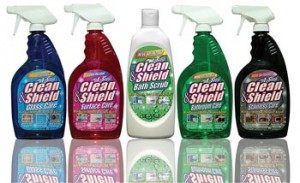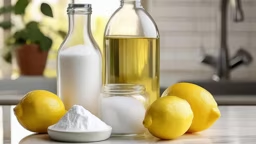 It's odd to think that the very things we use (liberally) to clean our homes might actually be more harmful to us than the germs, bacteria and mold we're trying to fight. Health problems — from skin sensitivity, allergies and asthma to liver disease, brain damage and cancer — have been linked to toxins found in cleaning products.
It's odd to think that the very things we use (liberally) to clean our homes might actually be more harmful to us than the germs, bacteria and mold we're trying to fight. Health problems — from skin sensitivity, allergies and asthma to liver disease, brain damage and cancer — have been linked to toxins found in cleaning products. Even if you heed the "harmful if swallowed" labels and don't down pints of caustic chlorine bleach, toxic substances are still harmful. You could scrub the tub in a biohazard suit, but once the chemicals go down the drain, they get leeched right back into your water supply. Likewise, residue left on surfaces, clothing, hair and skin is harmful and exposure you want to avoid. Here are some things to consider on your next trip down the cleaning aisle (and they may make you want to stay at home and mix your own).
Understanding Labels
Honest and accurate labeling of household cleaners has been a concern since 1960, especially when loopholes in legislation permit manufacturers to conceal dangerous ingredients. According to the National Research Council, only 1 percent of toxins are required to be listed on labels, because companies classify their formulas as trade secrets. Unless a product's ingredients cause an immediate side effect, consumers may not realize the risk of using such concoctions. (Additionally, testing is usually only done on one ingredient at a time, so unless you use one product to clean everything, there's a potential for hazardous chemical reactions). In an effort to inform consumers, eco-conscious organizations are promoting environmentally and health-friendly items by affixing Green Seal labels to non-toxic, non-corrosive and carcinogen-free cleaners. Be wary of other labels ("natural," "eco-friendly") that can be misleading because there are no established standards to verify the claim.Safe Scrubbing
Some companies are getting it right with natural ingredients and tools that clean without compromising the health of their customers. "The overuse of toxic chemicals in U.S. households is of concern," says Jeff Frankel, vice president of international and direct to consumer sales of Shark Euro-Pro, a cordless sweeper that emits no exhaust or airborne particles. "We're committed to being one of the leading companies in educating consumers on how to clean effectively without having to resort to toxic and abrasive products." Other earth-friendly grime-busters include the Shark Steam mop that converts tap water into steam to deep clean floors. Non-toxic, biodegradable sprays and solutions eliminate dirt and grease from countertops, bathtubs and sinks. Look for products that provide a long-lasting organic "barrier" against bacteria, mold and mildew, and that resist soap scum and rust stains. Unelko's (unelko.com) 1-Step Clean and Shield (above) does just this.Mixing Your Own
Another option: Mix your own household cleaners! The benefit of this is quality control: You know what goes in, and what doesn't. And effective, natural cleansers are often just behind cabinet doors. Baking soda, the multipurpose champ of bathroom, kitchen and refrigerator cleanup, is a powerful but gentle natural abrasive. Mix one part baking soda with one part water, or sprinkle directly on a damp cloth, to polish almost any surface. Non-toxic acids such as lemon juice and vinegar remove dirt and soap build-up. Lavender, grapefruit seed extract, and tea tree oil have antiseptic properties that attack mold and mildew. In a pinch, Huma Gruaz, President of Alpaytac, Inc., suggests simple soap and water, although in her opinion, nothing beats steam. "There are two ways to clean," Huma says. "One is chemically; the other with heat. Steam is as effective as chemical cleaners, if not better."More: Cleaning and Recycling Resources











